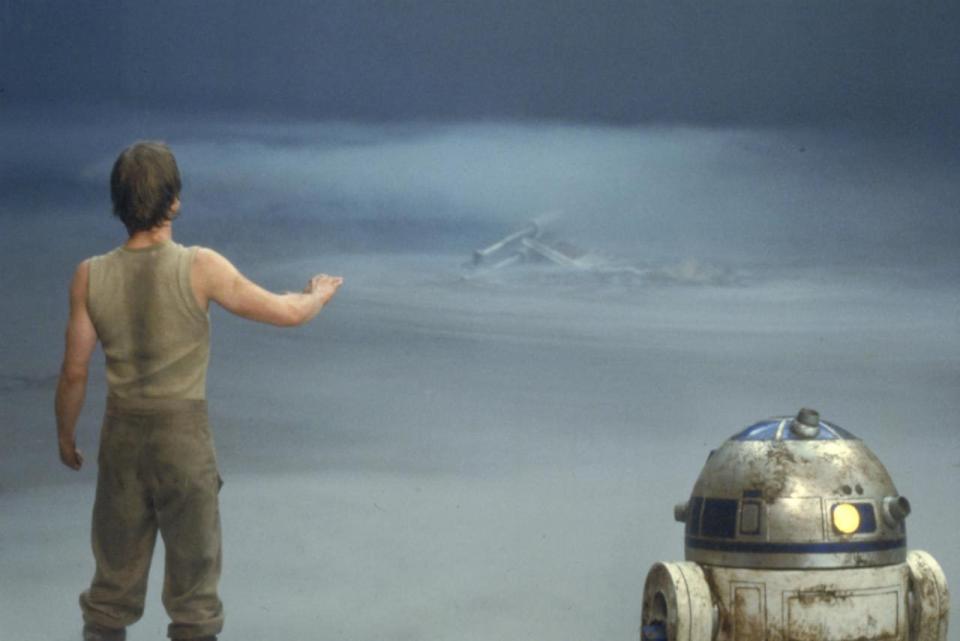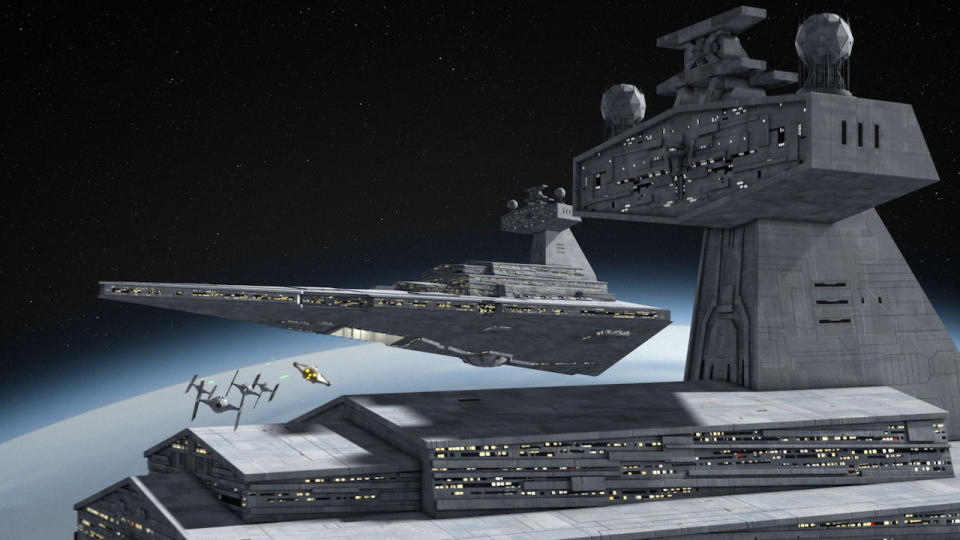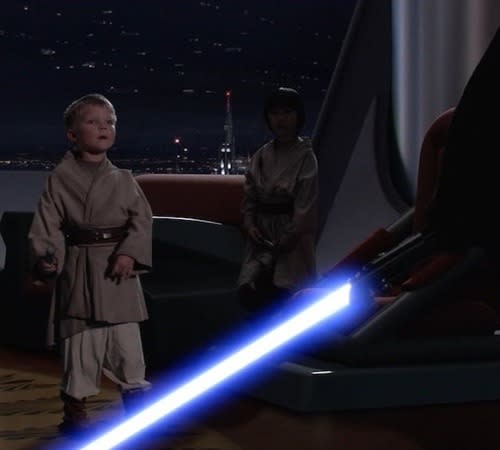6 Reasons ‘Star Wars’ Is So Much Better Than ‘Star Trek’
It’s probably the most contentious argument in all of nerd-dom: Which is the superior space opera, Star Wars or Star Trek? With both series being reborn for a new generation (in case you haven’t heard, Star Wars: The Force Awakens is hitting theaters Dec. 18, and Star Trek Beyond is coming to theaters in 2016) there has never been a better time to revisit this battle between the two most iconic franchises in science-fiction history.
Fighting for the Force is Yahoo Tech’s lead writer and Jedi-in-training, Daniel Howley. In the Star Trek corner is Yahoo Tech’s former editorial director, current editor-in-chief of Make magazine, and author of The Official Star Trek Trivia Book, Rafe Needleman.
(And if you’d rather just fight amongst yourselves, feel free to skip directly to the Comments section. No phasers or lightsabers allowed.) Engage!
1. Lightsabers are more awesome than phasers
As Obi-Wan Kenobi famously said, the lightsaber is a “more elegant weapon for a more civilized age.” A beam of pure energy, the glowing lightsaber is easily the most recognizable science-fiction weapon ever created.
Unlike Star Trek’s most famous weapon, the phaser, which can be used by anyone with opposable thumbs, lightsabers can be wielded only by either Jedi or Sith (and the occasional four-armed cyborg).

Heck, lightsabers are powerful enough to lop off a person’s arm with one swing, deflect blaster fire, and even cut through metal. What’s more, they come in a variety of forms: from the classic sabers used by Luke Skywalker and Darth Vader to Darth Maul’s double-ended saber and light whips.
A lightsaber’s owner even builds his or her own weapon, imbuing it with the Force and making it a part of them.
Phasers, meanwhile, are mass-produced by Star Trek’s Federation. Nothing about them is intrinsically interesting, beyond the fact that they can occasionally be set to stun.
If you had to choose between brandishing a lightsaber or a generic blaster, which would you pick?
I thought so.
2. Nothing can stop the Force
You can’t talk about Star Wars without mentioning the Force. A metaphysical power that permeates the Star Wars universe, the Force is what allowed Luke to lift his X-wing out of a swamp on Dagobah and Vader to choke his subordinates without ever touching them.

The added dimension of mysticism the Force brings to Star Wars makes it more than just another sci-fi story about aliens and spaceships. It gives the franchise a sense of wonder that’s more often associated with tales of wizards and magic than a space adventure.
(At this point, you’re probably wondering when I’ll mention midi-chlorians. Well, the answer is I won’t, because midi-chlorians were a terrible plot device that ruined the sense of mysticism that the original trilogy helped craft. We will speak of them no more.)

What is Star Trek’s equivalent? The Prime Directive, a bit of bureaucratic claptrap that says crew members cannot interfere with the natural evolution of primitive civilizations — which they still manage to violate in nearly every episode.
3. The ships are way better
The Millennium Falcon, star destroyers, Slave I, X-wings: Each of these ships is as iconic as the last. More than that, though, they each have their own personalities. From the Falcon’s temperamental engines and the X-wings’ characteristic S-foils to the Slave I’s bizarre upright design, the ships of the Star Wars universe are every bit a part of the story as the characters that pilot them.

True, Star Trek’s Enterprise is an icon unto itself, and it sure looks more comfortable than the Millennium Falcon’s cramped quarters. But Solo’s ship is as much an underdog as he is: It’s ugly, it breaks down, and it isn’t nearly as polished as the Empire’s ships.

That’s what makes the Falcon and the rest of the Republic’s ships so memorable. They’re long shots that, despite being outclassed, still manage to carry the day. And if there’s one thing people love, it’s an underdog.
4. Bigger heroes, better villains
When it comes to characters, Star Wars easily tops Star Trek. In just seven movies (plus two TV series, four theme parks, and 347 mostly awful video games), Star Wars managed to give us characters who were not only memorable but also fully formed. Star Trek has had 13 movies, seven TV series, and 246 mostly awful video games to inform its oeuvre — and yet Star Wars’ characters are still more relatable than Star Trek’s.

Quick, who’s your favorite captain? Han Solo is easily more likable than Capts. Kirk or Picard. He’s a scoundrel with a kind heart, but he’s not above preemptively blasting an alien bounty hunter when the time calls for it. (Yes, Han shot first!)
Then there are the villains. Star Trek’s Khan Noonien Singh is a wimp compared to Darth Vader. As Anakin Skywalker, the future Sith Lord murdered a bunch of children; then there are the countless people he killed using his Force choke or just plain cut down with his lightsaber. And let’s not forget that he ordered the torture of Leia and cut off his own son’s hand.

Kahn was certainly a despot, but he was never as purely evil as Vader was.
On the Light Side, while Luke is a bit of a wimp in A New Hope, he evolves into the ultimate hero. His character arc perfectly (and famously) emulates Joseph Campbell’s Hero’s Journey, which is the archetypal path for almost every hero ever created — you can draw a straight line from Homer’s Odysseus to Lucas’s Skywalker.

That’s perhaps the biggest reason Star Wars beats Star Trek. While Star Trek focuses on a pseudo-realistic future where science and understanding rule the day, Star Wars is more concerned with weaving a mythic tale that grabs you from its outset and never lets go.
With the exception of Jar Jar Binks. He is the Antichrist.
5. ‘Star Trek’ wants to be ‘Star Wars’
One of Star Trek’s main themes is that violence should only be used as a last resort. As such, there’s always been a lot of diplomatic back and forth in the franchise before everyone starts blasting away. (Also: whales. What was with the whales?)
Star Wars has always been about action. From lightsabers and blasters to massive ships crashing into other ships — and not one, but two, space stations that can destroy entire planets — Star Wars is the epitome of adventure movies.

With its newest movies, Star Trek has begun to follow a similar formula. Noble efforts at diplomacy are being replaced with the Enterprise and its crew battling adversaries across the galaxy. (The folks over at Cracked.com expertly pointed this out in their own piece explaining why Star Wars is better than Star Trek.)
I’m not complaining about Star Trek changing its formula; all I’m saying is you don’t see Chewbacca ordering “Earl Grey, hot” before negotiating a peaceful solution.
6. ‘Star Wars’ is my generation’s space opera
I’ve loved Star Wars since I was a kid. I can still remember the first time I watched the original trilogy on VHS; I am genuinely envious of people who got to experience the movies when they first premiered in theaters. I’ve read the books, I’ve played the games, and, of course, I had the toys.
And while I used to watch Star Trek: The Next Generation and Star Trek: Voyager with my parents whenever those shows were on, it never held the same kind of sway over my imagination that Star Wars did.

Maybe it’s because my best friend and I bonded over the movies and games in elementary school, or because my cousins and I watched the trilogy over and over when we were younger. Or maybe it’s because the idea that a single person can rise to a seemingly insurmountable challenge and make a difference gives me hope that I too can overcome anything life throws my way.
That, or maybe I just really like the toys.
Not a Star Wars fan? Then check out Rafe Needleman’s piece on why Star Trek is the superior sci-fi story.
More from Yahoo Tech:
13 Weird and Wacky (and Useful) iPhone Cases — Something for Every Type
The 10 Hottest Tech Gadgets of 2015, According to Yahoo Readers
Email Daniel at dhowley@yahoo-inc.com; follow him on Twitter at@DanielHowley or on Google+.

